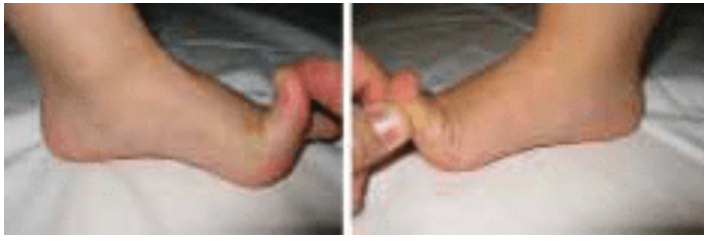Jack Test: Difference between revisions
(Created page with "<div class="noeditbox"> This article is currently under review and may not be up to date. Please come back soon to see the finished work! ({{REVISIONDAY}}/{{REVISIONMONTH}}/{{...") |
No edit summary |
||
| Line 3: | Line 3: | ||
</div> | </div> | ||
<div class="editorbox"> '''Original Editor ''' | <div class="editorbox"> '''Original Editor:''' [[User:Lauren Heydenrych|Lauren Heydenrych]] <br> | ||
'''Top Contributors''' - {{Special:Contributors/{{FULLPAGENAME}}}}</div> | '''Top Contributors''' - {{Special:Contributors/{{FULLPAGENAME}}}}</div> | ||
== Purpose<br> == | == Purpose<br> == | ||
The purpose of the Jack test (or Hubscher maneuver) is to determine if the presentation of pes planus in an individual is a fixed (rigid) or flexible deformity.<ref>Lee MS, Vanore JV, Thomas JL, Catanzariti AR, Kogler G, Kravitz SR, Miller SJ, Gassen SC. [https://docplayer.net/6084326-Diagnosis-and-treatment-of-adult-flatfoot.html Diagnosis and treatment of adult flatfoot. The Journal of Foot and Ankle Surgery]. 2005 Mar 1;44(2):78-113.</ref>It is important to differentiate flexible from fixed as the prognosis and intervention of the two presentations are vastly different. In addition, the presentation of a fixed flatfoot deformity flags possible underlying pathologies which could include cerebral palsy, other tone-influencing pathologies or tarsal coalition. | |||
While not being used as a diagnostic tool all on its own, this simple clinical test can be helpful when considered in context. | |||
Jack's test is often done in conjunction with the tip toe standing test.<br> | |||
== Technique<br> == | == Technique<br> == | ||
In it's initial description (1953), Jack's test was performed in weight bearing/ standing.<ref name=":0">Hicks JH. [https://www.bartoldclinical.com/wp-content/uploads/2021/05/hicks.-the-mechanics-of-the-foot-ii.-the-plantar-aponeurosis-and-the-arch.pdf The mechanics of the foot: II. The plantar aponeurosis and the arch]. Journal of anatomy. 1954 Jan;88(Pt 1):25.</ref> | |||
# The patient was to stand in a normal, relaxed position, | |||
# The clinician then passively flexes the 1st metatarsal joint (big toe). | |||
== Result and Interpretation == | |||
In a flexible pes planus, the following is observed:<ref name=":0" /> | |||
* The arch of the foot rises | |||
* The posterior part of the foot assumes an inverted position. | |||
* The leg rotates laterally. | |||
* A tight band is noted in the region of the plantar aponeurosis. | |||
[[File:Dorsiflexion of big toe.png|left|frame]] | |||
== Evidence == | == Evidence == | ||
Revision as of 21:58, 17 August 2022
This article is currently under review and may not be up to date. Please come back soon to see the finished work! (17/08/2022)
Purpose
[edit | edit source]
The purpose of the Jack test (or Hubscher maneuver) is to determine if the presentation of pes planus in an individual is a fixed (rigid) or flexible deformity.[1]It is important to differentiate flexible from fixed as the prognosis and intervention of the two presentations are vastly different. In addition, the presentation of a fixed flatfoot deformity flags possible underlying pathologies which could include cerebral palsy, other tone-influencing pathologies or tarsal coalition.
While not being used as a diagnostic tool all on its own, this simple clinical test can be helpful when considered in context.
Jack's test is often done in conjunction with the tip toe standing test.
Technique
[edit | edit source]
In it's initial description (1953), Jack's test was performed in weight bearing/ standing.[2]
- The patient was to stand in a normal, relaxed position,
- The clinician then passively flexes the 1st metatarsal joint (big toe).
Result and Interpretation[edit | edit source]
In a flexible pes planus, the following is observed:[2]
- The arch of the foot rises
- The posterior part of the foot assumes an inverted position.
- The leg rotates laterally.
- A tight band is noted in the region of the plantar aponeurosis.
Evidence[edit | edit source]
Provide the evidence for this technique here
Resources[edit | edit source]
add any relevant resources here
References[edit | edit source]
- ↑ Lee MS, Vanore JV, Thomas JL, Catanzariti AR, Kogler G, Kravitz SR, Miller SJ, Gassen SC. Diagnosis and treatment of adult flatfoot. The Journal of Foot and Ankle Surgery. 2005 Mar 1;44(2):78-113.
- ↑ 2.0 2.1 Hicks JH. The mechanics of the foot: II. The plantar aponeurosis and the arch. Journal of anatomy. 1954 Jan;88(Pt 1):25.







